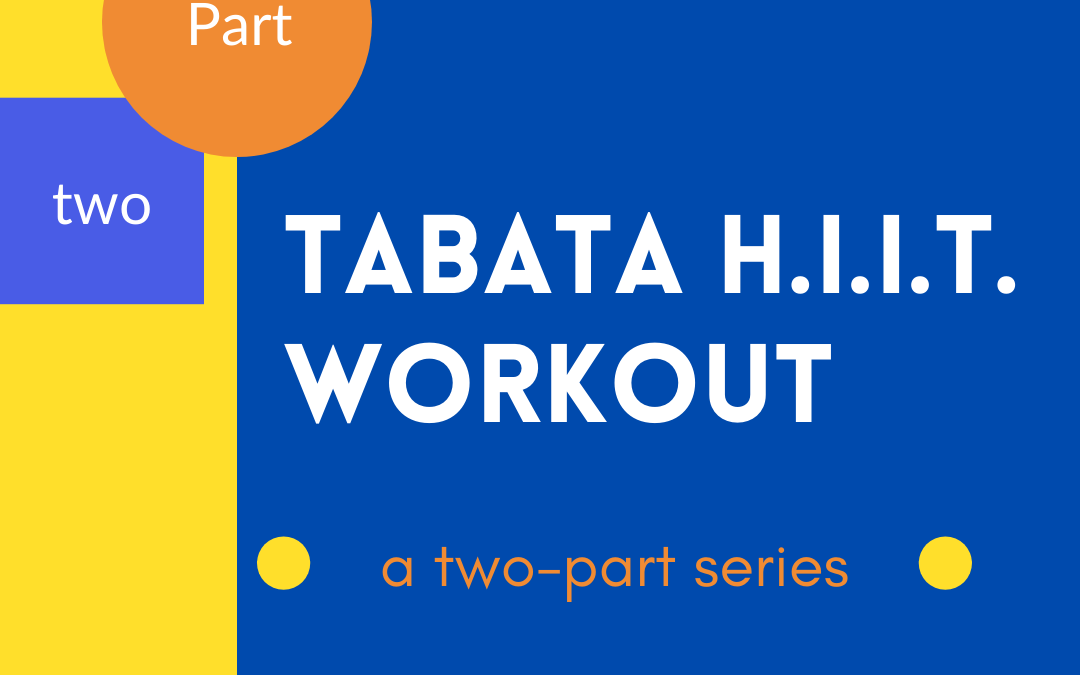Part 2: A 20-30 minute Tabata H.I.I.T. Workout!
Today’s post is the second part of our two-part series on Tabata workouts. The first post explained what is involved in this kind of high-intensity interval training. I summarize it below and provide a 25 to 30-minute workout you can do at home – no gym necessary.
What is Tabata Training:
Tabata is a high-intensity interval training (HIIT) workout, featuring exercises that last four minutes. For most (not all) people, it’s an all-around workout. I say most because it depends on your current fitness level and overall health. As always, please consult with a fitness trainer and/or your physician before you launch in an intensive workout.
The Tabata Workout:
The Tabata sets are four minutes long each:
- High-intensity exercise for 20 seconds (push yourself as hard as you can)
- Rest for 10 seconds. That’s one set.
- Do eight rounds per exercise for a total of four minutes.
- Do a minimum of 20-minutes.
The Tabata workout is an excellent way to kick up your metabolism, improve your overall fitness and muscle strength, and build endurance and speed.
Here are some Tabata exercises:
1) Squats:
- Stand with feet shoulder-width apart.
- Begin the squat with your hips by sitting back as if lowering into a chair.
- Keep head up and the plane of your back level and flat.
- Keep your weight on your heels, and do not allow your knees to go past your toes.
- You should feel like you’re going sit into the chair, except the range of motion of the hamstrings and hip will keep you from falling back.
2) Reverse Lunge:
- Stand with feet shoulder-width apart, hands at side or on your hips.
- Step back with right foot about one and a half times your regular stride length, land on the ball of that foot with your heel up.
- Lower the back leg straight down until it gently grazes the floor or close to, creating a 90-degree angle in the front leg.
- Push through the heel and midfoot of the front leg to return to standing, bringing your right foot back in line with your left.
- Repeat on the left side.
3) Burpees:
- Stand with feet shoulder-width apart, weight on your heels, and your arms at your sides.
- Push your hips back, bend your knees, and lower your body into a squat.
- Place your hands on the floor directly in front of, and just inside, your feet.
- Shift your weight onto your hands.
- Jump your feet back to land softly on the balls of your feet in a plank position. Your body should form a straight line from your head to heels. Do not let your back sag or your bottom stick up in the air.
- Jump your feet forward so that each foot lands just outside of your hands.
- Immediately extend your arms overhead and jump into the air.
- Land softly and immediately lower back into a squat for your next rep.
4) Mountain Climbers:
- Start in a traditional plank with your shoulders directly over your hands and wrists. Keep your back flat and your butt down to maintain a neutral spine.
- Engage your core by pulling your belly button toward your spine.
- Lift and bring your right knee toward your elbow. (It’s fine if you can’t bring the knee all the way to your elbow. )
- Return the right knee to the starting position and immediately bring your left knee up toward your left elbow.
- Return immediately to the starting position. Continue switching legs.
- To make it more challenging, increase the pace until it feels like you’re running in place in a plank position
5) Scissor kicks:
- Lie on your back with your legs extended out in front of you.
- Place your arms by your sides, palms down. For more back support, you can place your hands under lower back at the small of your back, palms pressing into the floor.
- Engage your core by pressing your lower back into the mat and tucking your pelvis. Maintain this position during the entire movement.
- Lift both legs about 6 to 12 inches off the ground.
- With your core engaged and neck relaxed, open both legs moving them apart.
- Continue the scissoring motions.
- To increase the intensity, keep arms and hands alongside your body, rather than under your back.
6) Lateral slide:
- Stand with your feet about hip-width apart and knees slightly bent into an almost-squat.
- Shuffle to the left side and reaching down to touch the floor with your left hand.
- Quickly shuffle/jump to the other side and repeat on the right side.
- Continue shuffling/jumping from side to side.
7) High knees:
- Run in place by bringing your knees up towards your chest.
- Legs should come up to waist height while engaging your lower abdominals.
- Use your arms to help you generate momentum.

